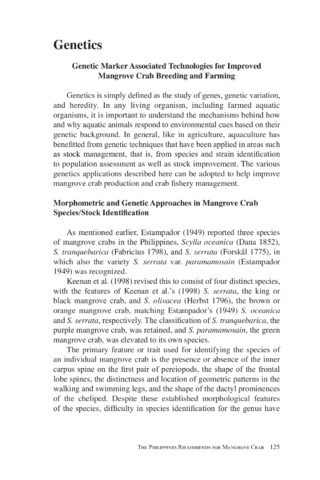Induction of moulting in hatchery-reared mangrove crab Scylla serrata juveniles through temperature manipulation or autotomy
- Global styles
- MLA
- Vancouver
- Elsevier - Harvard
- APA
- Help

View/
Date
2019Page views
2,652ASFA keyword
AGROVOC keyword
Taxonomic term
Metadata
Show full item record
Share
Abstract
The effects of temperature and autotomy of chelipeds on survival, growth and moulting of mangrove crab (Scylla serrata) juveniles were investigated under laboratory conditions for 60 days. Hatchery‐produced crabs with 2.0–2.3 cm internal carapace width (1.7–2.2 g body weight) at intermoult stage were exposed to one of four temperature treatments (constant 29, 32 or 35°C, or ambient [24–31°C]) or subjected to cheliped autotomy. All crabs held at 35°C had 100% mortality due to incomplete moulting during first moult. The mean survival of crabs at termination was 58%, 64% and 50% for ambient temperature, 29 and 32°C respectively. Specific growth rate (SGR) of crabs in the ambient and 29°C were comparable but significantly lower than those at 32°C. The moult interval of the crabs was significantly shorter in treatments with constant water temperature of 29 and 32°C compared with ambient temperature. The survival of crabs with intact chelipeds was comparable with those with one or two autotomized chelipeds. Crabs with intact or one autotomized chelipeds had significantly higher SGR than crabs with both chelipeds autotomized in the first moult. On the second moult, however, high SGR was observed in crabs with two chelipeds autotomized. The moult interval was significantly shorter in the autotomized crabs compared with crabs with intact chelipeds. The results suggest that the optimum water temperature for rearing S. serrata juveniles ranges from 29 to 32°C. Likewise, autotomy of chelipeds can promote moulting without adversely affecting survival of crabs.
Suggested Citation
de la Cruz-Huervana, J. J. Y., Quinitio, E. T., & Corre, V. L. (2019). Induction of moulting in hatchery-reared mangrove crab Scylla serrata juveniles through temperature manipulation or autotomy. Aquaculture Research , 50(10), 3000-3008. https://doi.org/10.1111/are.14257
Type
ArticleISSN
1355-557X; 1365-2109Collections
- Journal Articles [1258]
Related items
Showing items related by title, author, creator and subject.
-
[The Philippines recommends for mangrove crab:] Genetics
The Mangrove Crab Technical Committee 2018 (DOST-PCAARRD, 2021) -
Seasonal abundance, distribution and recruitment of mud crabs (Scylla spp.) in replanted mangroves
Walton, Mark E.; Le Vay, Lewis; Lebata, Junemie H. ; Binas, Joseph; Primavera, Jurgenne
; Binas, Joseph; Primavera, Jurgenne  (Elsevier, 2006)
The abundance and distribution of mud crabs were studied in a replanted mangrove forest in Buswang, Aklan, Philippines. Two fishing gears, lift nets and bamboo traps, were used to monitor relative abundance of Scylla spp. ...
(Elsevier, 2006)
The abundance and distribution of mud crabs were studied in a replanted mangrove forest in Buswang, Aklan, Philippines. Two fishing gears, lift nets and bamboo traps, were used to monitor relative abundance of Scylla spp. ... -
Updates on the larviculture of mud crab at SEAFDEC/AQD
Quinitio, Emilia T. ; Huervana, Joana Joy D. C.; Virgula, Juliette C.; Parado-Estepa, Fe D. (Aquaculture Department, Southeast Asian Fisheries Development Center, 2017)
Although the mud crab (Scylla serrata) hatchery technology has been developed, issues such as high cost of production due to the need for additional facilities and labor for natural food culture, inconsistent survival rate ...
; Huervana, Joana Joy D. C.; Virgula, Juliette C.; Parado-Estepa, Fe D. (Aquaculture Department, Southeast Asian Fisheries Development Center, 2017)
Although the mud crab (Scylla serrata) hatchery technology has been developed, issues such as high cost of production due to the need for additional facilities and labor for natural food culture, inconsistent survival rate ...





